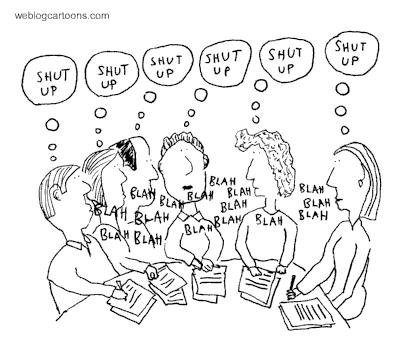
14 April, 2011 | Written by edward boches
譯者: DamnDigital‘s KK
When it comes to brainstorming, especially with large teams, one of the challenges is getting the loudmouths to shut up and the quieter members to speak up. Easier said than done. It gets harder still when a team is comprised of numerous disciplines or if the organization』s muscle memory defaults to a standard approach to problem solving, i.e. ad agencies think of ads, digital agencies forget about propagation, brands focus on products instead of social content.
當進行頭腦風暴, 特別是一大組人一起進行的時候, 讓大嘴巴們閉上嘴讓沉默者們出聲音絕對是一大挑戰。 說起來容易做起來難, 特別是當參與者由眾多領域的人員組成或者該團隊已慣於按一個標準方式來解決問題時, 這點做起來尤為艱難, 結果往往是, 在頭腦風暴中, 做廣告的思考著廣告, 做互動的忘記了傳播, 做品牌的沒有考慮社會內容而一味地關注著產品。
But one effective brainstorming approach is the 「shut up and write technique.」 Here』s how it works. Get everyone together — art, copy, strategy, mobile, tech, UX, media, social. Brief them on what you』re trying to do, the problem you』re hoping to solve, and the questions you need answered. (See this post on 「How might we?」) Then don』t let anyone talk. Make everyone shut up for 10 full minutes and write down ideas. If they can』t think of ideas have them write down questions or obstacles. You』ll be surprised what you get back. Instead of one or two or three of the 「typical」 ideas your teams usually generate, you』ll find suggestions that come from a wide range of perspectives.
而一個有效的頭腦風暴的方式是「讓嘴巴休息, 讓筆動起來」技巧, 這裡解釋一下這個技巧是如何工作的。讓所有的人坐在一起, 包括art, copy, strategy, mobile, tech, UX, media, social等。首先簡要地給他們介紹一下你想要做的, 你希望解決的, 你需要得到回答的。 然而並不讓任何一個人先發表意見。讓所有人閉嘴10分鐘, 將idea都寫下來。如果他們沒有什麼想法就讓他們將想到的問題和可能碰到的障礙寫下來。你會十分驚奇於你收回來的, 有別於常規你們能產生的一兩個「典型」 idea, 你會得到來自相當廣泛視角的提議 。
Here』s why it works. 現在來說說這個技巧為何有效。
The most assertive voices are neutralized 最武斷的聲音化為烏有
We all know that the loudest ideas aren』t always the best. It』s true also that ideas from the most senior people aren』t necessarily better than those from a rookie. By shutting everyone up the conversation doesn』t start with the boss or someone of rank saying, 「Here』s what I think.」
我們都知道叫得最響的idea不總是最棒的, 大牛的想法也並不必然比菜鳥的來得好。讓每個人都閉嘴, 頭腦風暴就不會在老闆或者某個高層的「這是我的想法」中開場了。
No one has to compete for the floor 不需要爭奪發言權
With large groups it』s common for people to think about getting their chance or planning when to chime in. That makes it harder to listen for anyone anxious to talk and it intimidates those who aren』t good at grabbing an opening. With this approach folks know that their ideas will get heard, as everyone gets a turn.
在大團隊中, 人們通常想著找到機會發言或者計劃何時插嘴。這使得傾聽別人變得很難, 同時也震懾住了那些不擅長抓住機會開口的人。而使用本技巧人們知道所有人的idea都會被聽到, 每個人都會被輪到。
People won』t be influenced by earlier comments 不會被先前的發言所左右
「Yes but,」 or 「How about if you did it this way instead?」 can advance the conversation but it can also put all the emphasis on one or two ideas. When everyone has a few minutes to think and focus there』s a tendency to come at it from one』s own perspective. You get a wider range of undeveloped ideas rather than a conversation that builds on one or two.
「是的, 但是」或者「你可以改成這麼做」能促進對話, 但是它同時也將重點集中在了一個或者兩個idea上。當所有的人都用幾分鐘時間去思考和關注, 每個人都從自身的視角出發, 你將得到大量未成熟的idea而不是一兩個建立在對話上的idea。
Everyone feels important and equal 每個人都覺得重要和平等
The 「shut up and write technique」 sends a message to everyone in the room that: a. they need to generate ideas and b. their ideas matter to the project. It』s a tactic that both demands and encourages participation.
「讓嘴巴休息, 讓筆動起來」技巧給每個在場的人傳遞了一個信息: 一是他們必須要有idea, 二是他們的idea對項目很重要。這是一個要求與激勵並存的戰術。
It focuses people on their area of expertise 使參與者專註於各自的專業領域
This might be the best reason of all. Getting people to write down what they think will work generally gets participants to draw on their their area of expertise. Developers don』t come up with ad ideas, they come up with programs, or platforms, or technological solutions. In an organization that defaults to one kind of solution, this can be quite refreshing.
這或許是使用本技巧最好的理由了。讓所有的人將他們思考的東西寫下來通常會讓參與者運用各自的專業領域。Developer們不去想廣告創意, 他們會去思考程序或平台, 抑或是技術解決方案。這對一個墨守成規的團隊來說將會是一個耳目一新的改變。
We did this today on a new business project. Two things happened. We got lots of unexpected ideas that a traditional creative team would never have generated. And we got a ton of positive feedback from all who were invited to join. Both good outcomes. Got any other brainstorming techniques you want to share?
我們今天在一個新的商業項目上運用了這個技巧, 結果發生了兩件事。一是我們得到了很多意想不到的idea, 而這對於一個傳統的創意團隊來說是根本不可能發生的。二是我們從所有的被邀請者那裡得到了好評如潮。都是好結果! 你還有其他頭腦風暴的技巧要與大家分享嗎?
Oh, and a huge thanks to Tim Leake, who introduced me to this technique. Thanks, Tim.
噢, 這裡要超級感謝一下Tim Leake, 是他向我介紹了這個技巧。謝謝你, Tim!
Cartoon by Dave Walker via DamnDigital



